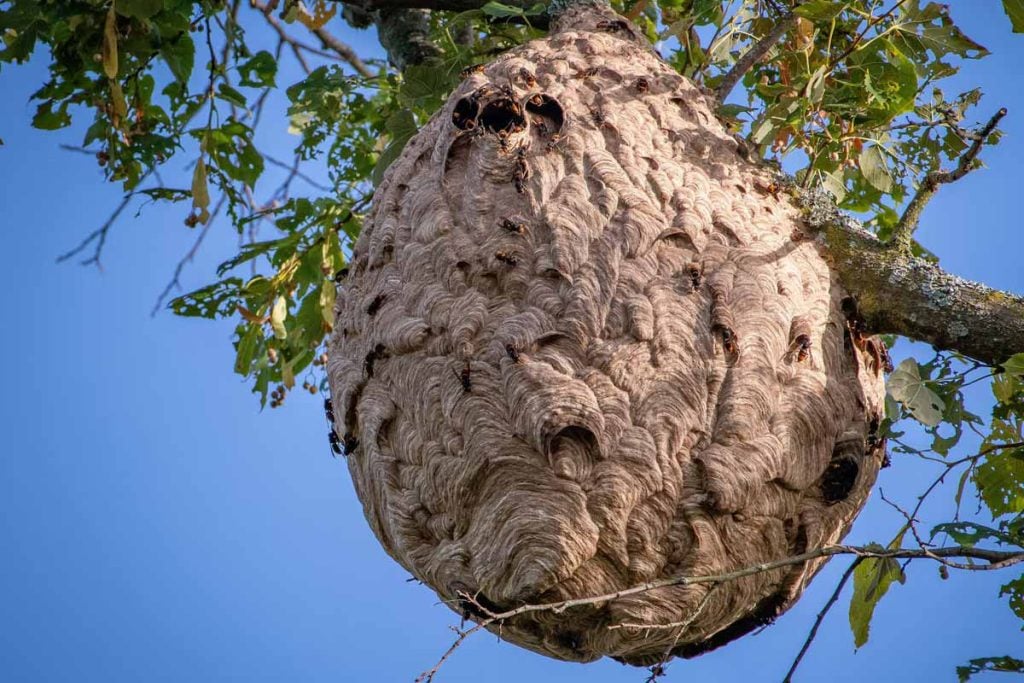A tiny tracker is tipping the balance in Britain’s race to locate hidden nests fast. Inspectors now tag Asian hornets with hair-thin transmitters, then follow a direct line home. The tactic saves days, protects bees, and helps officials contain this invasive hornet species without delay, while public vigilance rises across ports, towns, and farms.
Why this hornet species demands a rapid response
Asian hornets prey on honeybees and other pollinators that keep food systems afloat. A single colony can consume about 24 pounds of insects in one season, and that pressure stacks on top of habitat loss. Pollination underpins roughly one-third of the crops we eat, so every lost bee ripples through orchards and fields.
The new trackers matter because time favors the predator. Without technology, locating nests in high tree canopies can take days of patient watching, yet colonies can double in size within seven days at the peak. Faster find-and-destroy breaks that growth curve and eases pressure on local apiaries.
Britain’s goal isn’t merely control; it’s eradication before the invader settles in. Testing shows the country has prevented permanent colonies from taking root. Last year, only three of 24 nests came from females that survived a British winter, which signals progress even as reports increase.
How micro-trackers turn hours into minutes
The workflow now follows a straightforward field script, then cuts search time dramatically. Inspectors capture individual hornets near bait stations, loop an ultralight transmitter around the thorax, and release the insect. Teams then follow the signal straight to the nest, often reaching it within an hour instead of several days.
Speed reshapes operations because removal windows are short. Crews need to bag and destroy nests before the next brood emerges, while nearby beekeepers brace for raids. The method reduces fuel, labor, and guesswork, so budgets stretch further and more sites get cleared in a single shift.
This targeted approach also limits collateral stress on landscapes. Instead of wide sweeps, officers move with surgical accuracy, and landowners get faster reassurance. The result protects bees, improves data on incursion routes, and, crucially for a spreading hornet species, keeps new queens from escaping.
Public vigilance keeps the hornet species at bay
Citizen eyes extend the state’s reach, while simple tools make reporting easy. Through the Asian Hornet Watch app, people submit thousands of sightings that trigger rapid checks. Many alerts cluster near ports, since hornets often arrive hidden in shipments of wine, produce, or building materials.
Officials pair that vigilance with clear messaging. Tracy Wilson of the Animal and Plant Health Agency notes that people are seeing more hornets, which can feel like establishment, yet surveillance shows otherwise. Some survive, but they are not thriving in the U.K., and eradication efforts continue at pace.
Data track with that message. Britain’s records indicate containment is holding, while tracking improves response time and accuracy. The app, then, becomes both an early-warning net and a feedback loop. People report, teams act, and communities see results, which encourages still more high-quality reports about this hornet species.
Numbers, origins, and the race against growth
Through August 2025, Britain’s Animal and Plant Health Agency found 64 nests, a seasonal record that reflects sharper detection as well as higher pressure. According to reporting in The Guardian, the European invasion began in 2004 when a single female likely reached France inside a pottery shipment from China.
France now hosts an estimated 500,000 colonies, and that scale illustrates the stakes if surveillance slips. Asian hornets hunt at hive entrances, so losses stack quickly. When pollinators decline, everything from apples to almonds grows vulnerable, while growers already juggle climate stress and tight margins.
Britain’s containment hasn’t happened by chance; it flows from speed. Trackers collapse the search window, while teams remove nests before growth surges. Colonies can double within seven days during peak season, yet a swift hit prevents new queens. That matters greatly with any fast-spreading hornet species.
What homeowners can do to protect pollinators
Residential yards can assist in stabilizing regional ecosystems while government agencies track colonies. Substituting sections of water-intensive turf with indigenous plants benefits bees that adapted with regional nectar and pollen. Those plants typically require less irrigation and upkeep, which reduces expenses and liberates weekends without compromising street appearance.
Alternatives exist for varying preferences and climates. Clover turf provides gentle texture and continuous flowering; buffalo grass withstands heat and minimal watering; xeriscaping with area wildflowers introduces color while sustaining pollinator pathways. Even modest transformations create impact because fragmented habitats still nourish bees.
Homeowners should also stay alert and report sightings through the app rather than attempting removal. Inspectors use bait stations, transmitters, and protective gear for a reason, since nests can sit high in canopies. Reporting quickly, then planting for resilience, blunts the edge of this hornet species.
What matters next and how to stay one step ahead
Officials expect pressure to rise as climate patterns shift, yet the tracker program is scaling and should see wider deployment within two years. Britain’s record—only three of 24 nests last year from overwintered females—suggests eradication remains feasible. Collective action, smart yards, and rapid reporting keep this hornet species from turning seasonal incursions into a permanent foothold.
